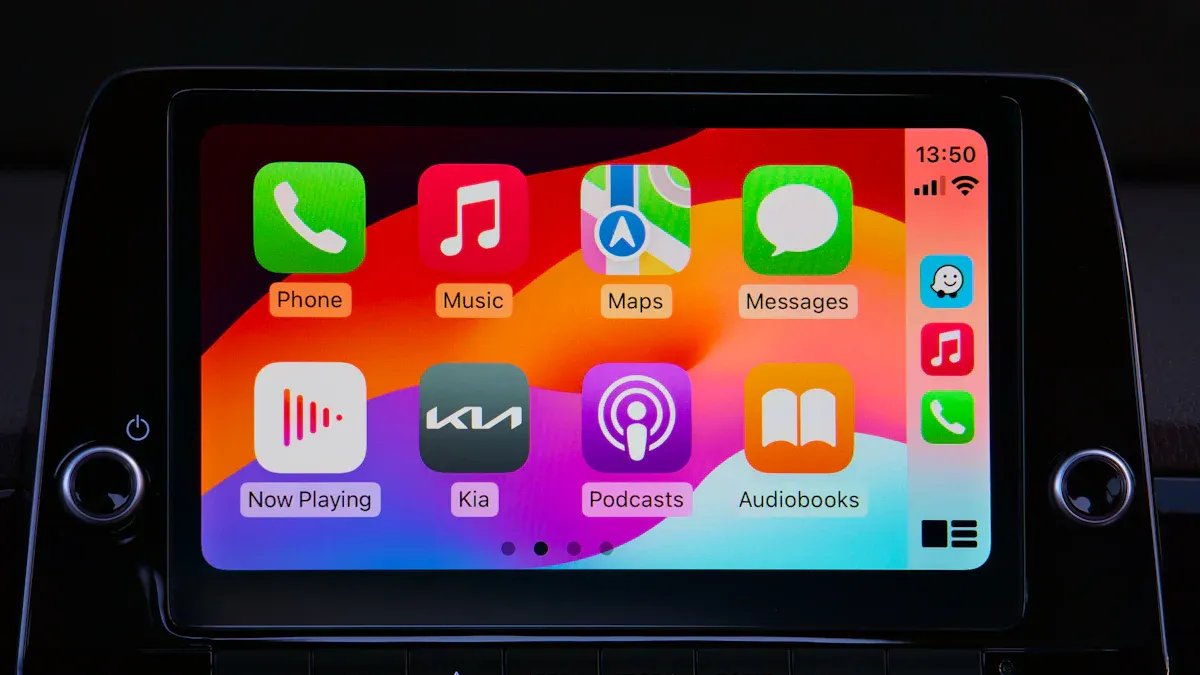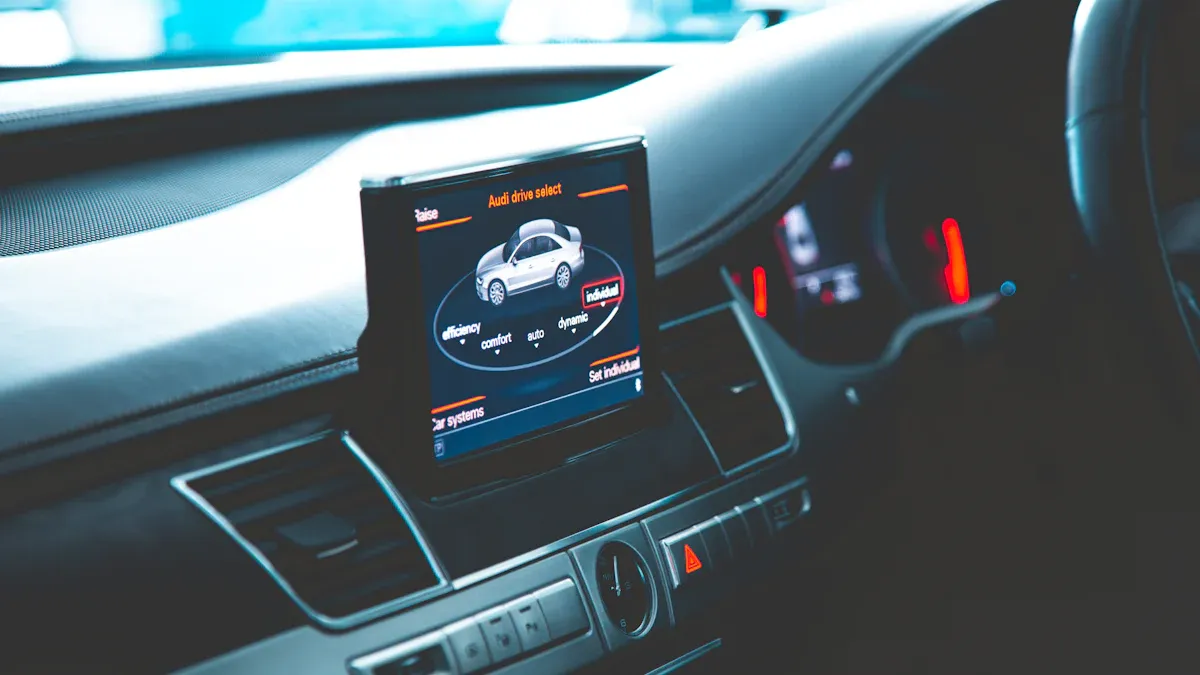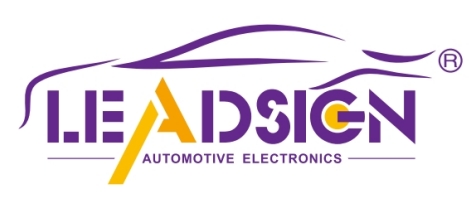How to Use a CarPlay Converter for Wireless Connectivity

Picture starting your car and connecting to CarPlay right away. No need to mess with cables anymore. A CarPlay converter helps by changing your wired system to wireless. It’s perfect for people who love easy solutions. With wireless Apple CarPlay, you can use music, maps, and calls easily. This lets you stay focused on driving safely.
Key Takeaways
A CarPlay converter changes your wired system to wireless. This lets you connect without using cables.
To set it up, plug the converter into your car's USB port. Then, follow the steps shown on the screen.
Wireless CarPlay makes things easier. You can use apps while your phone stays in your pocket. It also helps avoid messy cables.
Understanding CarPlay Converters
What is a CarPlay converter?
A CarPlay converter is a small gadget, often called a dongle. It changes your car's wired CarPlay system into a wireless one. You connect it to your car’s USB port for wireless use. Unlike wired CarPlay, it doesn’t need a Lightning cable. Wireless CarPlay uses Bluetooth or Wi-Fi to link your phone to the car. This means you can use CarPlay without plugging in your phone. Devices like the Ottocast U2-AIR make this process easy. They are quick to set up and work with most cars.
Benefits of using a wireless CarPlay converter
Using a wireless CarPlay converter has many advantages. Here’s a simple list:
Feature | Benefit |
|---|---|
No cables needed, but CarPlay works fully. | |
Plug-and-Play Setup | Plug it into USB, and it’s ready. |
Wide Compatibility | Works with most cars that have wired CarPlay. |
Enhanced Convenience | Use apps while keeping your phone in your pocket. |
Reduced Cable Clutter | Makes getting in and out of the car easier. |
Additional Features | Some converters pair faster and stay connected better. |
These features make wireless CarPlay more fun and easy to use. You’ll love having fewer cables and quick access to apps like Maps or Spotify.
Why switch from wired CarPlay to wireless?
Wired CarPlay is good, but wireless CarPlay is better. Imagine starting your car and connecting to CarPlay instantly. No cables to mess with or worry about damaging your phone’s port. Wireless systems are becoming more popular and reliable. Bluetooth and Wi-Fi technology keep improving every year. The market for car infotainment is growing fast, expected to hit $41.2 billion by 2033. This shows how much drivers want easy smartphone connections in their cars.
Switching to wireless CarPlay isn’t just about ease—it’s about the future. Whether driving to work or taking a trip, wireless CarPlay makes it all better.
How to Set Up a Wireless CarPlay Converter

Picking the right CarPlay converter for your car
Choosing the best CarPlay converter is the first step. Not all converters fit every car, so check if it’s compatible. Find converters that match your car’s system and support wireless CarPlay. Some, like the LEADSIGN BMW decoder, are made for specific brands like BMW. Others, such as the Carlinkit series, work with many car models.
When deciding, focus on these important points:
Metric | What It Means |
|---|---|
Compatibility Checks | Makes sure the converter works with your car. |
Connection Stability | Ensures a steady connection without interruptions. |
Performance Metrics | Includes fast start-up and smooth operation. |
User Feedback | Shares real-life reviews about ease of use and reliability. |
If unsure, read the manual or check reviews online. Many brands, like Carlinkit, offer guides to help you choose. These manuals are often available on their websites.
Setting up the CarPlay converter
Setting up a CarPlay converter is simple. Most are plug-and-play, meaning you just connect them to your car’s USB port. Follow these steps:
Find your car’s USB port.
Plug the CarPlay converter into the USB port.
Wait for it to turn on. Look for an LED light to confirm.
Follow the instructions on your car’s screen to finish setup.
Some converters, like the LEADSIGN BMW decoder, have extra features like screen mirroring. If yours does, check the manual for more details.
For help, here are manuals for popular models:
Connecting your phone to the wireless CarPlay system
After setup, pair your phone with the converter. This step connects your iPhone to the wireless CarPlay system. Follow these steps:
Step 1: Turn on Bluetooth on your iPhone.
Step 2: Find the CarPlay converter in the Bluetooth list and pair it.
Step 3: The converter will create a Wi-Fi network. Connect your phone to this network for faster data.
Step 4: After setup, your phone will reconnect automatically when you start your car.
This process is quick and easy. It ensures you can use CarPlay without any trouble.
Testing and fixing the wireless connection
Once paired, test the connection to make sure it works. Play music, use maps, or make a call to check everything. If there’s a problem, try these tips:
Check signals: Make sure Bluetooth and Wi-Fi signals are strong.
Restart devices: Restart your phone or converter to fix small issues.
Update firmware: Look for updates for your CarPlay converter. Updates can fix bugs.
Check settings: Make sure your phone’s CarPlay settings are turned on.
If problems continue, read the manual or contact support. Many brands offer troubleshooting guides to help fix common issues.
Pro Tip: Keep your iPhone updated. New iOS versions improve wireless CarPlay performance.
Compatibility of Wireless CarPlay Converters
Checking if your car supports wireless CarPlay
Before using wireless CarPlay, check if your car allows it. Most newer cars with wired CarPlay can use a wireless converter. Older cars or those without a compatible system may need upgrades.
Here’s how to check compatibility:
Read your car’s manual. It will mention wireless CarPlay support.
Visit the car maker’s website for model-specific details.
Test a wireless CarPlay converter in your car. If it works, you’re set!
Some cars, like BMWs, have advanced systems that work well with wireless CarPlay. For instance, the LEADSIGN BMW decoder is made for BMW models and integrates smoothly. If unsure, ask your car dealer or the converter’s support team for help.
Popular car brands and their compatibility with CarPlay converters
Not all car brands work equally well with wireless CarPlay. Some brands are more compatible than others. Here’s a quick comparison:
Car Brand | Works with Wireless CarPlay Adapters? |
|---|---|
Kenwood | Yes |
Pioneer | Yes |
JVC | Yes |
Alpine | Yes |
Sony | Yes |
If you own one of these brands, you’re in luck! These systems are known for working well with wireless CarPlay converters. However, some aftermarket systems may need extra adjustments. Always double-check before buying a converter.
Resolving common compatibility issues
Even the best wireless CarPlay converters can have problems. Don’t worry—most issues are simple to fix. Here are common problems and solutions:
Connectivity Issues: If CarPlay disconnects, check Bluetooth and Wi-Fi signals. Weak signals can cause problems.
Setup Problems: Some converters need careful installation, especially with rear cameras. Follow the manual closely.
Software Bugs: Update your converter’s firmware. Updates often fix bugs and improve performance.
Temperature Problems: Extreme heat or cold can affect the converter. Park in shade or use a sunshade.
Sound Quality: If audio isn’t clear, consider upgrading your car’s speakers.
Here’s a table of these issues:
Problem Type | Description | How Often? |
|---|---|---|
Connectivity Issues | Wireless CarPlay disconnects, needing re-pairing. | Common |
Setup Problems | Rear camera setups can be tricky for some users. | Some users |
Software Bugs | Freezing or unresponsive screens were reported by a few users. | Rare |
Temperature Problems | Extreme weather affects converter performance. | Some users |
Sound Quality | Built-in speakers may not give the best sound. | Some users |
Pro Tip: Update your iPhone to the latest iOS version. Updates improve wireless CarPlay and fix bugs.
Wireless CarPlay uses Bluetooth and Wi-Fi for easy use. While it removes cables, it can sometimes disconnect. If problems persist, contact the converter’s support team for help.
Comparing the Best Wireless CarPlay Converters
Features to look for in a CarPlay converter
When picking a CarPlay converter, focus on features that improve driving. Here are important things to consider:
Compatibility: Check if it works with your car and supports wireless CarPlay. Some, like the LEADSIGN BMW decoder, are made for certain brands. Others work with many cars.
Connection Speed: Choose one that connects fast when starting your car. Look for quick boot times and steady Wi-Fi links.
Ease of Use: Plug-and-play converters are simple to set up. Avoid ones that take too long to install.
Extra Features: Some have cool extras like screen mirroring or HDMI output. These are great if you enjoy watching videos while parked.
Firmware Updates: Regular updates keep the converter working with new iOS versions and fix bugs.
By focusing on these, you’ll find a CarPlay converter that works best for you.
Pros and cons of top-rated CarPlay converters
Not all CarPlay converters are the same. Here’s a quick look at the good and bad of popular ones:
Model | Pros | Cons |
|---|---|---|
LEADSIGN BMW Decoder | Great for BMWs, supports wireless CarPlay and Android Auto. | Only works with BMWs, costs more than others. |
Carlinkit 4.0 | Works with most cars, connects fast, and easy to use. | Some users report it disconnects at times. |
Ottocast U2-AIR | Small size, starts quickly, and works well. | Doesn’t have extras like HDMI output or video casting. |
Motorola MA1 | Strong connection, nice design, and affordable price. | Only works with Android Auto, not for CarPlay. |
Each converter has its pros and cons. Pick one based on what you need most, like speed or extra features.
Changing to wireless CarPlay makes driving much easier. Over 70% of drivers now prefer wireless systems. Bluetooth and Wi-Fi help you connect quickly. Voice commands let you stay focused while driving. Upgrade now for more convenience and better features!
FAQ
How can I check if my car works with a wireless CarPlay converter?
Look in your car’s manual for CarPlay information.
Check the car maker’s website for compatibility details.
Try using a converter to see if it works.
Tip: Not sure? Ask the converter’s support team for help.
Can Android phones work with a wireless CarPlay converter?
Some converters, like the LEADSIGN BMW decoder, work with both CarPlay and Android Auto. Read the product details to confirm it supports Android devices.
What can I do if my wireless CarPlay keeps disconnecting?
Restart both your phone and the converter.
Update the firmware on your converter.
Make sure Bluetooth and Wi-Fi signals are strong.
Pro Tip: Update your phone’s iOS to improve performance.
See Also
Guide to Achieving Wireless Functionality with Apple CarPlay Adapter
Steps to Wirelessly Connect Your Apple CarPlay Adapter
Installing a Wireless Adapter for Apple CarPlay in Your Vehicle
Effortless Wireless Connection for Cars Lacking Apple CarPlay

